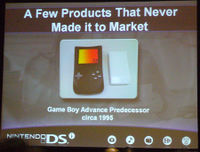| Site Notice |
|---|
|
We have a limited coverage policy. Please check our coverage page to see which articles are allowed. |
Difference between revisions of "Game Boy Advance predecessor"
(Created page with "[[File:GBA predecessor.jpg|thumb|200px|The '''Game Boy Advance predecessor''' as shown at {{wp|Game Developers Conference|GDC}} 2009, compared in size to a [[Nintendo DS Lite]...") |
m |
||
| Line 1: | Line 1: | ||
[[File:GBA predecessor.jpg|thumb|200px|The '''Game Boy Advance predecessor''' as shown at {{wp|Game Developers Conference|GDC}} 2009, compared in size to a [[Nintendo DS Lite]].]] | [[File:GBA predecessor.jpg|thumb|200px|The '''Game Boy Advance predecessor''' as shown at {{wp|Game Developers Conference|GDC}} 2009, compared in size to a [[Nintendo DS Lite]].]] | ||
| − | The "'''Game Boy Advance predecessor'''" was a handheld game console intended to be the successor to the [[Game Boy]]. According to [[Masato Kuwahara]], the system was in development around 1995, and was intended | + | The "'''Game Boy Advance predecessor'''" was a handheld game console intended to be the successor to the [[Game Boy]]. According to [[Masato Kuwahara]], the system was in development around 1995, and was intended to launch before the {{wp|1996 Summer Olympics}}.<ref name="GDC 2009">[http://www.gamasutra.com/view/news/113860/GDC_Nintendo_Reveals_1000_Point_DSiWare_Promotion_New_Game_for_the_US_DSi_Secrets.php GDC: Nintendo Reveals 1,000 Point DSiWare Promotion, New Game for the U.S., DSi Secrets]. Gamasutra (March 25, 2009). Retrieved January 6, 2017.</ref> |
While the device uses a similar form factor to the original Game Boy, it also features two additional buttons, similar to the layout of a [[Super Nintendo Entertainment System Controller|SNES Controller]]. The hardware would have also featured a color {{wp|Liquid crystal display|LCD}} screen, and used a 32-bit {{wp|ARM7}} CPU.<ref name="GDC 2009"/> However, the large size of the device led to it being cancelled, as the developers could not make the system small enough to fit in one's pocket.<ref name="GDC 2009"/> Kuwahara also stated that the ARM7 was inefficient, leading to performance issues.<ref name="GDC 2009"/> | While the device uses a similar form factor to the original Game Boy, it also features two additional buttons, similar to the layout of a [[Super Nintendo Entertainment System Controller|SNES Controller]]. The hardware would have also featured a color {{wp|Liquid crystal display|LCD}} screen, and used a 32-bit {{wp|ARM7}} CPU.<ref name="GDC 2009"/> However, the large size of the device led to it being cancelled, as the developers could not make the system small enough to fit in one's pocket.<ref name="GDC 2009"/> Kuwahara also stated that the ARM7 was inefficient, leading to performance issues.<ref name="GDC 2009"/> | ||
Revision as of 22:27, 6 January 2017
The "Game Boy Advance predecessor" was a handheld game console intended to be the successor to the Game Boy. According to Masato Kuwahara, the system was in development around 1995, and was intended to launch before the 1996 Summer Olympics.[1]
While the device uses a similar form factor to the original Game Boy, it also features two additional buttons, similar to the layout of a SNES Controller. The hardware would have also featured a color LCD screen, and used a 32-bit ARM7 CPU.[1] However, the large size of the device led to it being cancelled, as the developers could not make the system small enough to fit in one's pocket.[1] Kuwahara also stated that the ARM7 was inefficient, leading to performance issues.[1]
References
- ↑ 1.0 1.1 1.2 1.3 GDC: Nintendo Reveals 1,000 Point DSiWare Promotion, New Game for the U.S., DSi Secrets. Gamasutra (March 25, 2009). Retrieved January 6, 2017.
| |||||||||||||||||||||
| |||||||||||||||||||||
| |||||||||||||||||||||


